Intel Ghost Canyon NUC9i9QNX Review: NUC 9 Extreme Realizes the SFF Dream
by Ganesh T S on April 16, 2020 8:05 AM ESTSPECworkstation 3 Benchmark
SFF PCs traditionally do not lend themselves to workstation duties. However, the capabilities of the Ghost Canyon NUC encouraged us to benchmark the unit as a content creation machine. Other professional workloads were also processed using the SPECworkstation 3.0.4 benchmark from the SPEC Graphics & Workstation Performance Group.
The SPECworkstation 3 benchmark measures workstation performance based on a number of professional applications. It includes more than 140 tests based on 30 different workloads that exercise the CPU, graphics, I/O and memory hierarchy. These workloads fall into different categories.
- Media and Entertainment (3D animation, rendering)
- Product Development (CAD/CAM/CAE)
- Life Sciences (medical, molecular)
- Financial Services
- Energy (oil and gas)
- General Operations
- GPU Compute
Individual scores are generated for each test and a composite score for each category is calculated based on a reference machine (HP Z240 tower workstation using an Intel E3-1240 v5 CPU, an AMD Radeon Pro WX3100 GPU, 16GB of DDR4-2133, and a SanDisk 512GB SSD). The SPEC Ratio for the tests in each category is presented in the graphs below.
Media and Entertainment
The Media and Entertainment category comprises of workloads from five distinct applications:
- The Blender workload measures system performance for content creation using the open-source Blender application. Tests include rendering of scenes of varying complexity using the OpenGL and ray-tracing renderers.
- The Handbrake workload uses the open-source Handbrake application to transcode a 4K H.264 file into a H.265 file at 4K and 2K resolutions using the CPU capabilities alone.
- The LuxRender workload benchmarks the LuxCore physically based renderer using LuxMark.
- The Maya workload uses the SPECviewperf 13 maya-05 viewset to replay traces generated using the Autodesk Maya 2017 application for 3D animation.
- The 3ds Max workload uses the SPECviewperf 13 3dsmax-06 viewset to replay traces generated by Autodesk's 3ds Max 2016 using the default Nitrous DX11 driver. The workload represents system usage for 3D modeling tasks.
| SPECworkstation 3.0.4 - Media and Entertainment Workloads | |||
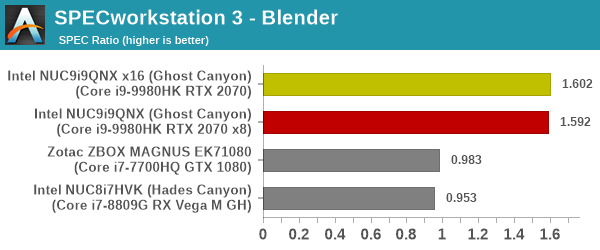
We find the Ghost Canyon NUC performing better than the reference configuration across all content creation workloads typically seen in the media and entertainment industry.
Product Development
The Product Development category comprises of eight distinct workloads:
- The Rodinia (CFD) workload benchmarks a computational fluid dynamics (CFD) algorithm.
- The WPCcfd workload benchmarks another CFD algorithm involving combustion and turbulence modeling.
- The CalculiX workload uses the Calculix finite-element analysis program to model a jet engine turbine's internal temperature.
- The Catia workload uses the catia-05 viewset from SPECviewperf 13 to replay traces generated by Dassault Systemes' CATIA V6 R2012 3D CAD application.
- The Creo workload uses the creo-02 viewset from SPECviewperf 13 to replay traces generated by PTC's Creo, a 3D CAD application.
- The NX workload uses the snx-03 viewset from SPECviewperf 13 to replay traces generated by the Siemens PLM NX 8.0 CAD/CAM/CAE application.
- The Solidworks workload uses the sw-04 viewset from SPECviewperf 13 to replay traces generated by Dassault Systemes' SolidWorks 2013 SP1 CAD/CAE application.
- The Showcase workload uses the showcase-02 viewset from SPECviewperf 13 to replay traces from Autodesk’s Showcase 2013 3D visualization and presentation application
| SPECworkstation 3.0.4 - Product Development Workloads | |||
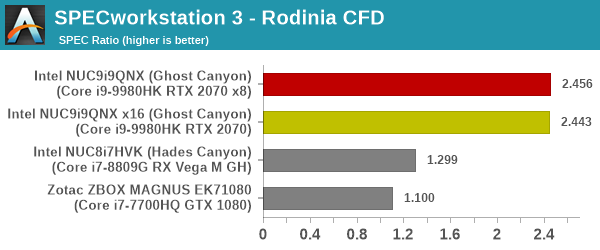
Almost all workloads see the Ghost Canyon NUC performing significantly better than the reference configuration. The NX workload alone seems to suffer, likely on account of the trace requiring features supported in professional graphics cards.
Life Sciences
The Life Sciences category comprises of four distinct test sets:
- The LAMMPS set comprises of five tests simulating different molecular properties using the LAMMPS molecular dynamics simulator.
- The NAMD set comprises of three tests simulating different molecular interactions.
- The Rodinia (Life Sciences) set comprises of four tests - the Heartwall medical imaging algorithm, the Lavamd algorithm for calculation of particle potential and relocation in a 3D space due to mutual forces, the Hotspot algorithm to estimate processor temperature with thermal simulations, and the SRAD anisotropic diffusion algorithm for denoising.
- The Medical workload uses the medical-02 viewset from SPECviewperf 13 to determine system performance for the Tuvok rendering core in the ImageVis3D volume visualization program.
| SPECworkstation 3.0.4 - Life Sciences Workloads | |||
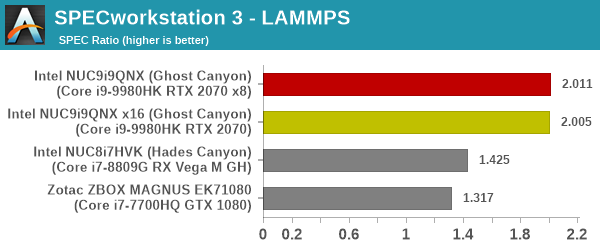
The trend repeats for all test sets in this category also, with the Ghost Canyon NUC acquitting itself in a creditable manner.
Financial Services
The Financial Services workload set benchmarks the system for three popular algorithms used in the financial services industry - the Monte Carlo probability simulation for risk assessment and forecast modeling, the Black-Scholes pricing model, and the Binomial Options pricing model.
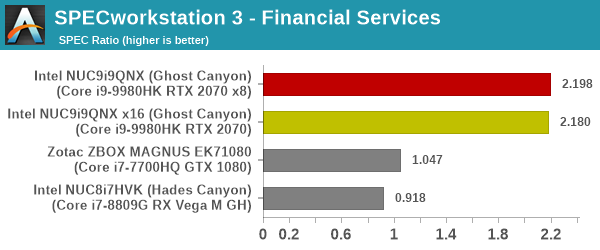
The large core count and ability to turbo to speeds of up to 5 GHz enable the NUC9i9QNX to process these algorithms in a fast manner.
Energy
The Energy category comprises of workloads simulating various algorithms used in the oil and gas industry:
- The FFTW workload computes discrete Fourier transforms of large matrices.
- The Convolution workload computes the convolution of a random 100x100 filter on a 400 megapixel image.
- The SRMP workload processes the Surface-Related Multiples Prediction algorithm used in seismic data processing.
- The Kirchhoff Migration workload processes an algorithm to calculate the back propogation of a seismic wavefield.
- The Poisson workload takes advantage of the OpenMP multi-processing framework to solve the Poisson's equation.
- The Energy workload uses the energy-02 viewset from SPECviewperf 13 to determine system performance for the open-source OPendTec seismic visualization application.
| SPECworkstation 3.0.4 - Energy Industry Workloads | |||

The NUCs seem to perform very poorly in the SRMP and Poisson workloads, but are otherwise quite good in the workloads in this category.
General Operations
In the General Options category, the focus is on workloads from widely used applications in the workstation market:
- The 7zip workload represents compression and decompression operations using the open-source 7zip file archiver program.
- The Python workload benchmarks math operations using the numpy and scipy libraries along with other Python features.
- The Octave workload performs math operations using the Octave programming language used in scientific computing.
- The Storage workload evaluates the performance of the underlying storage device using transaction traces from multiple workstation applications.
| SPECworkstation 3.0.4 - General Operations | |||
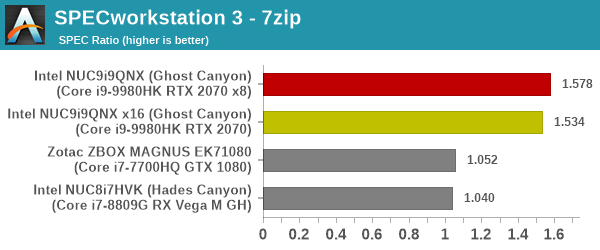
The Core i9-9980HK performs much better than the reference configuration as well as the older generation CPUs for the general operations. The storage results is again particularly interesting to analyze. Directly connecting the Optane SSD to the CPU's PCIe lanes results in a 40%+ performance improvement for the storage traces of professional applications.
GPU Compute
In the GPU Compute category, the focus is on workloads taking advantage of the GPU compute capabilities using either OpenCL or CUDA, as applicable:
- The LuxRender benchmark is the same as the one seen in the media and entertainment category.
- The Caffe benchmark measures the performance of the Caffe deep-learning framework.
- The Folding@Home benchmark measures the performance of the system for distributed computing workloads focused on tasks such as protein folding and drug design.
| SPECworkstation 3.0.4 - GPU Compute | |||
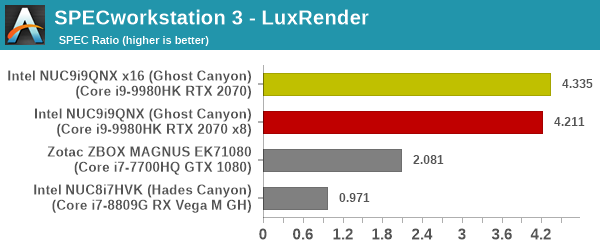










109 Comments
View All Comments
buckiller - Thursday, April 16, 2020 - link
Power pig. Hades Canyon was great, but this is hot trash, relative to expectations set by last-gen and perf/power capabilities that are possible today.> The Ghost Canyon NUC9i9QNX is a SFF enthusiast's dream come true.
Ooph. Hardly.
Dolda2000 - Thursday, April 16, 2020 - link
I have to admit that I still don't really see the point of this system. It seems that its main gimmick is the fact that what is essentially the motherboard plugs into a PCIe riser card. That's fine and useful and all, but PCIe riser boards and cables are nothing new, and I don't really see what this does that hasn't already been doable for quite some time. You can replace the compute element? Sure, but being able to replace motherboards is nothing new to most form factors. Please do enlighten me if I'm missing something.Dragonstongue - Thursday, April 16, 2020 - link
the series adds the ability for end-users to add a standard PCIe video card to the system system.to the system's system ... or just to the system..
as for folks complain about the price, CPU alone is ~580 USD .. RTX 2070 mini ~539
so there is over $1k right there
I personally wouldn't be buying NUC "overall" based on should be Ryzen A and B absolutely not given seems Intel is "up to their same old BS tricks" via "preventing" folks from offering AMD based options available...
Destoya - Thursday, April 16, 2020 - link
$580 CPU, you have to be kidding. Nobody, including OEMs, pays the tray MSRP intel has listed.If you want to look at it in terms of value, it has the same performance as a Ryzen 3600 ($175)...
Deicidium369 - Thursday, April 16, 2020 - link
First off, there are no OEMs, it is single source Intel. I love Intel NUCs - not sure what the use case for this model is.Namisecond - Friday, April 17, 2020 - link
I don't think Intel manufactures those CPU cards (soldered BGA CPUs). They're probably integrated by a 3rd party OEM like Foxxcon. It's one thing to have engineering samples, but for Intel to step into the motherboard manufacturing game requires a lot of capital resources...unless the NUC parts are actually going to be made at Intel's engineering labs...If it's a production run in the 10Ks...that just might be feasible.Deicidium369 - Friday, April 17, 2020 - link
And like I said there are no OEMs available for you to buy from - single source - Intel. I thought I saw something a few years ago about possibly PNY - I know they do the Nvidia branded graphics cards.BlazingDragon - Thursday, April 16, 2020 - link
The article is misleading... and very Intel biased, IMHO.The ~$1500 USD price is for the i9 barebones kit only... just compute element [w/CPU], daughter board and PSU - i.e. not including a GPU, DRAM memory or SSD - that's why it's so outlandish...
Good ITX m/board & Ryzen 3900x CPU, plus really nice case and PSU is << $900 USD.
Deicidium369 - Thursday, April 16, 2020 - link
So a review of a product from Intel is very Intel biased.... That has to be a huge conspira-plotBlazingDragon - Thursday, April 16, 2020 - link
A review of anything can be positive or negative on that thing... and is unbiased if it seems balanced and fair in that criticism [be it positive or negative].If said article seems to over exaggerate the positives, and/or misrepresent them, and miss out or under call some of the negatives, then yes, it's biased... and IMHO, that's exactly what this article does...